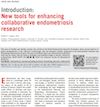To facilitate the advancement of research into endometriosis the World Endometriosis Research Foundation (WERF) today releases global standardised tools for the collection of biological samples and data in endometriosis research.
The work involves collaboration among 34 academic endometriosis research centres and three diagnostic/pharmaceutical companies – an unprecedented initiative for a single disease.
Through these standardised data and bio-specimen collection tools, published in the scientific journal Fertility and Sterility [1-5], it may now be possible to discover distinct sub-types of endometriosis leading the way towards specifically targeted treatments for the disease.
Abandoning “one-size-fits-all” has revolutionised success in the diagnosis and treatment of other diseases, such as certain cancers and heart disease.
However, for endometriosis these discoveries currently lag behind. One of the two Principal Investigators, Associate Professor Stacey Missmer of Harvard University, explains:
Associate Professor Stacey Missmer, Harvard University (USA)
We know little about what causes endometriosis, nor what allows the disease to persist, which limits successful diagnosis, treatment, cure, and prevention for the millions of girls and women whose lives are affected daily by this painful disease.
We do know that endometriosis looks and behaves differently among women – but not which patterns and differences are important to target. Consequently the science of endometriosis has been held back due to small studies with limited, highly selective, patients that have, so far, made identification of these unique disease sub-groups impossible.
said Professor Missmer.
Big data can solve complex scientific issues
To facilitate the robust, large, international collaborations necessary to improve diagnosis and treatment of endometriosis, WERF gathered a team of 54 academia and industry experts from 16 countries to develop standardised collection tools and protocols – the WERF Endometriosis Phenome and Biobanking Harmonisation Project (EPHect).
Associate Professor Krina Zondervan, Oxford University (UK)
EPHect is the first successful standardisation of data and sample collection at such a global scale for a single disease
asserted the other Principal Investigator, Associate Professor Krina Zondervan of Oxford University.
Big data can solve complex clinical scientific issues, and we encourage every single centre that is serious about research in endometriosis to take up the challenge to enter into global collaboration by using these freely available protocols to advance our field.
Only when sufficient and consistent data have been gathered do we stand a real chance to understand the causes and characteristics of different endometriosis sub-types, which will enable the development of targeted treatments for the millions of girls and women who rely on us to find a solution to their struggle with this disease.
concluded Professor Zondervan.
World Endometriosis Society President, Professor Linda Giudice, adds:
The WERF EPHect collaboration is a landmark in endometriosis research worldwide. The global consensus of detailed phenotypic characterisation and standard operating procedures is anticipated to provide a platform to interpret biochemical, genetic/epigenetic, genomic and quality of life data relevant to endometriosis symptoms and therapies. It is a dynamic series and will likely be amended as more is learned over time – truly a great effort!
The WERF EPHect tools are freely available from www.endometriosisfoundation.org/ephect.
References
- Becker CM, et al. World Endometriosis Research Foundation Endometriosis Phenome and Biobanking Harmonisation Project: I. Surgical phenotype data collection in endometriosis research. Fertil Steril 2014 doi 10.1016/j.fertnstert.2014.07.709
- Vitonis AF, et al. World Endometriosis Research Foundation (WERF) Endometriosis Phenome and Biobanking Harmonization Project: II. Clinical and covariate phenotype data collection in endometriosis research. Fertil Steril 2014 doi 10.1016/j.fertnstert.2014.07.1244
- Rahmioglu N, et al. WERF Endometriosis Phenome and Biobanking Harmonization Projec: III. Fluid biospecimen collection, processing, and storage in endometriosis research. Fertil Steril 2014 doi 10.1016/j.fertnstert.2014.07.1208
- Fassbender A, et al. World Endometriosis Research Foundation Endometriosis Phenome and Biobanking Harmonisation Project: IV. Tissue collection, processing, and storage in endometriosis research. Fertil Steril 2014 doi 10.1016/j.fertnstert.2014.07.1209
- Casper RF. New tools for enhancing collaborative endometriosis research. Fertil Steril 2014 doi: 10.1016/j.fertnstert.2014.07.1211
Want to make a difference?
The World Endometriosis Research Foundation (WERF) was created in 2006 as the first global charity to facilitate collaborative research in endometriosis to improve knowledge and treatments.
Its vision is a day when no woman suffers from the pain of endometriosis or is prevented from having children due to the disease. Click here to donate to research in endometriosis.




